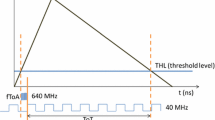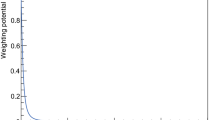Abstract
The reconstruction of the tracks of charged particles with high precision is crucial for HEP experiments to achieve their physics goals. The BESIII drift chamber, which is used as the tracking detector of the BESIII experiment, has suffered from aging effects resulting in degraded tracking performance after operation for approximately 15 years. To preserve and enhance the tracking performance of BESIII, one of the proposals is to add one layer of a thin cylindrical CMOS pixel sensor based on state-of-the-art stitching technology between the beam pipe and the drift chamber. The improvement in the tracking performance of BESIII with such an additional pixel detector compared to that with only the existing drift chamber was studied using the modern common tracking software acts, which provides a set of detector-agnostic and highly performant tracking algorithms that have demonstrated promising performance for a few high-energy physics and nuclear physics experiments.





Similar content being viewed by others
Data availability
The data that support the findings of this study are openly available in Science Data Bank at https://www.doi.org/10.57760/sciencedb.13616 and https://cstr.cn/31253.11.sciencedb.13616.
Notes
Suppose the wire has a direction of \(\textbf{w}\) and the track direction is \(\textbf{t}\) in the global coordinate frame, the x axis and y axis in the local coordinate frame of a line surface is \(\textbf{w} \times \textbf{t}\) and \(\textbf{w}\), respectively.
References
M. Ablikim, Z.H. An, J.Z. Bai et al., Design and construction of the BESIII detector. Nucl. Instrum. Meth. A 614, 345–399 (2010). https://doi.org/10.1016/j.nima.2009.12.050
C.Z. Yuan, S.L. Olsen, The BESIII physics programme. Nat. Rev. Phys. 1, 480–494 (2019). https://doi.org/10.1038/s42254-019-0082-y
M. Ablikim, M.N. Achasov, P. Adlarson et al., Future physics programme of BESIII *. Chin. Phys. C 44, 040001 (2020). https://doi.org/10.1088/1674-1137/44/4/040001
X.X. Cao, W.D. Li, C.L. Liu et al., Studies of dE/dx measurements with the BESIII. Chin. Phys. C 34, 1852 (2010). https://doi.org/10.1088/1674-1137/34/12/012
M.Y. Dong, Q.L. Xiu, L.H. Wu et al., Aging effect in the BESIII drift chamber*. Chin. Phys. C 40, 016001 (2016). https://doi.org/10.1088/1674-1137/40/1/016001
Y.J. Xie, Z.H. Qin, X.Y. Ma et al., Construction and cosmic-ray test of the new inner drift chamber for BESIII. Chin. Phys. C 40, 096003 (2016). https://doi.org/10.1088/1674-1137/40/9/096003
A. Bortone, Development and operation of the CGEM Inner Tracker for the BESIII experiment. Nucl. Instrum. Meth. Phys. Res. Sect. A 1048, 167957 (2023). https://doi.org/10.1016/j.nima.2022.167957
S. Bohndiek, A. Blue, J. Cabello et al., Characterization and testing of LAS: a prototype ‘large area sensor’ with performance characteristics suitable for medical imaging applications. IEEE Trans. Nucl. Sci. 56, 2938–2946 (2009). https://doi.org/10.1109/TNS.2009.2029575
A. Konstantinidis, M. Szafraniec, R. Speller et al., The Dexela 2923 CMOS X-ray detector: a flat panel detector based on CMOS active pixel sensors for medical imaging applications. Nucl. Instrum. Meth. Phys. Res. Sect. A 689, 12–21 (2012). https://doi.org/10.1016/j.nima.2012.06.024
M. Farrier, T. Achterkirchen, G. Weckler et al., Very large area CMOS active-pixel sensor for digital radiography. IEEE Trans. Electron Devices 56, 2623–2631 (2009). https://doi.org/10.1109/TED.2009.2031001
G. Aglieri Rinella, Developments of stitched monolithic pixel sensors towards the ALICE ITS3. Nucl. Instrum. Meth. Phys. Res. Sect. A 1049, 168018 (2023). https://doi.org/10.1016/j.nima.2023.168018
X. Ai, C. Allaire, N. Calace et al., A common tracking software project. Comput. Softw. Big Sci. 6, 8 (2022). https://doi.org/10.1007/s41781-021-00078-8
ATLAS Collaboration, Software Performance of the ATLAS Track Reconstruction for LHC Run 3. Tech. rep., CERN, Geneva, all figures including auxiliary figures are available at https://atlas.web.cern.ch/Atlas/GROUPS/PHYSICS/PUBNOTES/ATL-PHYS-PUB-2021-012 (May 2021)
H. Abreu, J. Anders, C. Antel et al., First direct observation of collider neutrinos with FASER at the LHC. Phys. Rev. Lett. 131, 031801 (2023). https://doi.org/10.1103/PhysRevLett.131.031801
J.D. Osborn, A.D. Frawley, J. Huang et al., Implementation of ACTS into sPHENIX track reconstruction. Comput. Softw. Big Sci. 5, 23 (2021). https://doi.org/10.1007/s41781-021-00068-w
X. Ai, X. Huang, Y. Liu, Implementation of ACTS for STCF track reconstruction. J. Instrument. 18, P07026 (2023). https://doi.org/10.1088/1748-0221/18/07/P07026
BESIII Offline Software System. https://bes3.readthedocs.io/index.html
A. Dorokhov, G. Bertolone, J. Baudot et al., High resistivity CMOS pixel sensors and their application to the STAR PXL detector. Nucl. Instrum. Meth. Phys. Res. Sect. A 650, 174–177 (2011). https://doi.org/10.1016/j.nima.2010.12.112
G. Aglieri Rinella, The ALPIDE pixel sensor chip for the upgrade of the ALICE inner tracking system. Nucl. Instrum. Meth. Phys. Res. Sect. A 845, 583–587 (2017). https://doi.org/10.1016/j.nima.2016.05.016
Y. Ji, sPHENIX Collaboration, Heavy flavor physics with the sphenix maps vertex tracker upgrade. Nucl. Phys. A 1005, 121792 (2021). https://doi.org/10.1016/j.nuclphysa.2020.121792
S. Dong, P. Yang, Y. Zhang et al., Design and characterisation of the JadePix-3 CMOS pixel sensor. Nucl. Instrum. Meth. Phys. Res. Sect. A 1048, 167967 (2023). https://doi.org/10.1016/j.nima.2022.167967
M. Dong, X. Ju, X. Tian et al., Development of maps-based detector ladders for the besiii inner tracker upgrade. Nucl. Instrum. Meth. Phys. Res. Sect. A 924, 287–292 (2019).https://doi.org/10.1016/j.nima.2018.06.032
K.X. Huang, Z.J. Li, Z. Qian et al., Method for detector description transformation to unity and application in besiii. Nucl. Sci. Tech. 33, 142 (2022). https://doi.org/10.1007/s41365-022-01133-8
S. Jadach, B.F.L. Ward, Z. Was, Coherent exclusive exponentiation for precision Monte Carlo calculations. Phys. Rev. D 63, 113009 (2001). https://doi.org/10.1103/PhysRevD.63.113009
D.J. Lange, The EvtGen particle decay simulation package. Nucl. Instrum. Meth. A 462, 152–155 (2001). BEAUTY2000, Proceedings of the 7th International Conference on B-Physics at Hadron Machines. https://doi.org/10.1016/S0168-9002(01)00089-4
Geometry Description Markup Language (GDML)., https://gdml.web.cern.ch/GDML
S. Agostinelli, J. Allison, K. Amako et al., Geant4-a simulation toolkit. Nucl. Instrum. Meth. Phys. Res. Sect. A 506, 250–303 (2003). https://doi.org/10.1016/S0168-9002(03)01368-8
Q.G. Liu, S.L. Zang, W.G. Li et al., Track reconstruction using the TSF method for the BESIII main drift chamber. Chin. Phys. C 32, 565 (2008). https://doi.org/10.1088/1674-1137/32/7/011
Y. Zhang, X.Y. Zhang, W.D. Li et al., Pattern-matching track reconstruction for the BESIII main drift chamber. High Energy Phys. Nucl. Phys. 31, 570–575 (2007)
L.K. Jia, Z.P. Mao, W.D. Li et al., Study of low momentum track reconstruction for the BESIII main drift chamber. Chin. Phys. C 34, 1866 (2010). https://doi.org/10.1088/1674-1137/34/12/014
J. Zhang, Y. Zhang, H.M. Liu et al., Low transversemomentum track reconstruction based on the Hough transform for the BESIII drift chamber. Radiation Detect. Technol. Methods 2, 20 (2018). https://doi.org/10.1007/s41605-018-0052-4
C.L. Ma, Y. Zhang, Y. Yuan et al., An extended segment pattern dictionary for a pattern matching tracking algorithm at BESIII. Chin. Phys. C 37, 066202 (2013). https://doi.org/10.1088/1674-1137/37/6/066202
J.K. Wang, Z.P. Mao, J.M. Bian et al., BESIII track fitting algorithm. Chin. Phys. C 33, 870 (2009). https://doi.org/10.1088/1674-1137/33/10/010
R. Brun, A. Gheata, M. Gheata, The ROOT geometry package. Nucl. Instrum. Methods. Phys. Res. A 502, 676–680 (2003). https://doi.org/10.1016/S0168-9002(03)00541-2
R. Frühwirth, A. Strandlie, Track Finding, (Springer International Publishing, Cham, 2021), pp. 81–102. https://doi.org/10.1007/978-3-030-65771-0_5
Author information
Authors and Affiliations
Contributions
All authors contributed to the study conception and design and material preparation. The analysis was performed by Yi Liu, Guang-Yan Xiao and Ya-Xuan Li. The first draft of the manuscript was written by Xiao-Cong Ai and Ling-Hui Wu, and all authors commented on previous versions of the manuscript. All authors read and approved the final manuscript.
Corresponding author
Ethics declarations
Conflict of interest
The authors declare that they have no competing interests.
Additional information
This work was supported by the National Natural Science Foundation of China (Nos. U2032203, 12275296, 12275297, 12075142, 12175256, 12035009) and National Key R &D Program of China (No. 2020YFA0406302).
Rights and permissions
Springer Nature or its licensor (e.g. a society or other partner) holds exclusive rights to this article under a publishing agreement with the author(s) or other rightsholder(s); author self-archiving of the accepted manuscript version of this article is solely governed by the terms of such publishing agreement and applicable law.
About this article
Cite this article
Liu, Y., Ai, XC., Xiao, GY. et al. Simulation study of BESIII with stitched CMOS pixel detector using acts. NUCL SCI TECH 34, 203 (2023). https://doi.org/10.1007/s41365-023-01353-6
Received:
Revised:
Accepted:
Published:
DOI: https://doi.org/10.1007/s41365-023-01353-6




